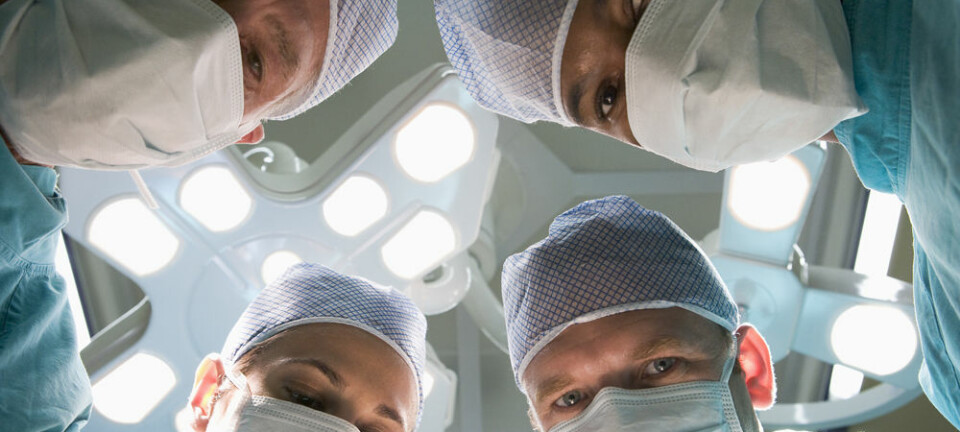
How should doctors and nurses break bad news to patients?
Delivering a tough message to a patient is often perceived as so difficult that it doesn’t go very well, according to both a professor and a doctor.
The Lion's Mouth Opens is a documentary film about actress Marianna Palka in the time leading up to her doctor's appointment to find out whether she will develop Huntington's disease.
The message from the doctor could change her life, allowing the viewer to immediately imagine what Palka must be experiencing as she anticipates receiving this information.
But doctors’ and nurses’ feelings can also influence how they convey that message to the patient, writes Stine Eileen Torp Løkkeberg in her doctoral dissertation.
“Telling someone something that will alter their view of their own future is just plain hard – even if you have a lot of experience,” says Løkkeberg.
Doctors and nurses worry about whether they can do it well enough, and how the patient will react to the news, she says.
And Løkkeberg’s studies show that the feelings a situation arouses for a doctor or nurse affect what he or she says and does face to face with a patient.
"Conveying a message like this often goes less well than hoped for, because it’s so hard to do," says Pål Gulbrandsen, a professor at the University of Oslo’s Institute of Clinical Medicine.
How to deliver bad news?
Many people struggle when they have to share something upsetting or hurtful with others. They want to do it in the best way possible, for themselves and for the person concerned – even if it is only a negative evaluation of a colleague and not a life and death matter.
Løkkeberg ran six studies for her doctorate in social psychology, in which over 900 participants considered different scenarios and had to imagine how they would convey tough messages.
In one scenario, participants were asked to imagine giving critical feedback on a fellow student’s presentation. In another, medical students had to imagine telling a patient that he or she had a serious illness. In another scenario, nursing students imagined how they would follow up on the doctor’s conversation with the patient.
Løkkeberg also had students look at three different ways to break the bad news: first, in a direct manner without sensitivity to the patient's feelings; second, with a very empathetic manner that toned down the negative and focused on the positive; and third, using an honest, yet empathetic manner.
This last option is called a person-centred approach, where the patient’s experience of the situation is important.
The dissertation shows that this method produces the least emotional distress for the messenger bearing the bad news, which is consistent with other studies showing that the recipient is also less uncomfortable when communication is person-centred.
“Participants experienced the direct and unempathic communication of bad news as the most unpleasant – ‘you have this disease, here’s the prognosis, that’s it,’” says Løkkeberg, who took her doctorate at the University of Kent.
Self-critical feelings
Even experienced doctors and nurses may have difficulty communicating news that turns a patient’s life on its head. Løkkeberg’s studies show that health personnel’s feelings and perceptions during patient interviews may influence what they communicate.
“For example, if as a doctor you’re very worried that others will dislike you, you might distance yourself from the situation. If you’re concerned about self-image and that you may have hurt someone, you might be more inclined to want to repair the relationship,” she says.
“Our experience of ourselves in these situations affects how clearly we communicate with the patient,” says Løkkeberg.
“Often we become self-critical in these difficult meetings because we’re unsure of ourselves, our interaction with others and whether what we do or say is right. We’re not sure how much to disclose or hold back,” she adds.
Lack of training
A lot of research exists on how the patient experiences meeting with healthcare personnel, but few researchers have attempted to explain the uncomfortable feelings from the perspective of the messenger.
Løkkeberg believes that medical and nursing students in Norway learn too little about the self-critical feelings they experience as the bearers of bad news, and what those feelings mean for their encounters with patients, relatives and colleagues.
Tools exist to help health professionals communicate with patients. The problem, in Løkkeberg’s view, is that they only focus on the patient's and loved ones' feelings, and leave out the other party – health professionals – in the communication dialogue.
It’s not always possible to plan for these challenging meetings, she says, but often doctors know they will be sharing difficult news with patients and their families. She proposes inserting a preparation phase before meeting with the patient, so that the health personnel involved become aware of their own feelings around the situation.
“As it stands now, this is left up to the individual health professional,” she says.
None of Løkkeberg’s studies have involved real encounters between patients and health personnel, so there is no guarantee that the results would have been the same in actual meetings in the hospital or doctor's office.
But in studies she has done, she observed that the more serious the imagined situation was, the greater the participants found the emotional discomfort.
"When the patient starts to cry, I’m done"
Pål Gulbrandsen has seen extreme and brutal examples of doctors who have chosen a direct and unempathetic style of delivering bad news to the patient.
“It probably doesn’t happen often, but I've seen when a doctor breaks the news to the patient and then just exits the room. Once a doctor said to me, ‘When the patient begins to cry, I can’t do anything else, I’m done,’” Gulbrandsen says.
Gulbrandsen has taught patient communication to doctors and medical students for 25 years. One of the most important things he conveys to medical students is that they must understand their own reactions before they can understand and communicate well with a patient. A recent class of new medical students was surprised by this.
Gulbrandsen told them that they would be hearing a lot about patients, but that no one would be talking to them about their own vulnerability.
“I told them, ‘You have to understand your feelings, accept them and reconcile with them. Then you’ll be prepared to face these difficult situations with a patient,’” he says.
Communication skills taken for granted
Gulbrandsen believes that it takes time for some health workers to learn to be aware of and reconcile with their own feelings of discomfort. He also thinks students require mentorship when they start working in their profession.
“Behavioural training and real coursework are key, along with someone who guides and watches the young professionals as they practice what they’re learning,” he says.
Gulbrandsen agrees with Løkkeberg that this kind of training is lacking today, although he finds that the interest in improving these skills has increased over the last decade.
But it is not common practice for new doctors to have a more experienced doctor join them in difficult patient meetings. No one is supervised when they conduct their first difficult conversation, according to the professor.
He finds that unacceptable.
“No one would have let me into a surgical procedure without having watched others do it first and without someone watching what I did in the beginning. Yet we take these communication skills for granted,” he says.
Gulbrandsen thinks it is important to emphasize that many doctors are good at communicating with patients, but part of the problem is that doctors have no theoretical language with which to pass this on to new doctors.
“They can’t necessarily tell you what they’re doing well, whereas a surgeon has the language for what he does in a person’s stomach,” he says.
Nurses have a stronger tradition
Nursing education includes more training precisely in patient communication.
“Nurses learn a lot of empathic communication skills. Doctors should also be empathic, but they also need to convey complex factual information. It’s a demanding combination,” says Gulbrandsen.
Nurses have a stronger tradition of observing each other when they perform tasks and a stronger culture of having young, new recruits accompany more experienced nurses and learn from them. A doctor who starts working at a hospital, doesn’t have this support,” he says.
-------------------------------------
Read the Norwegian version of this article at forskning.no
































